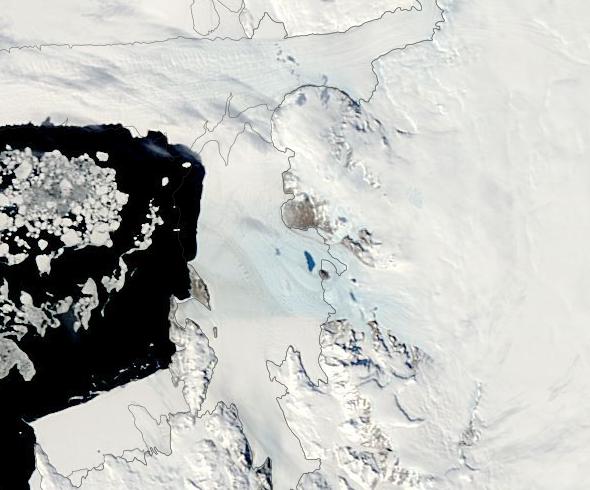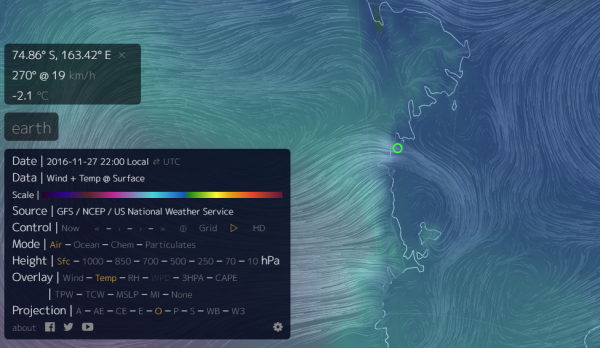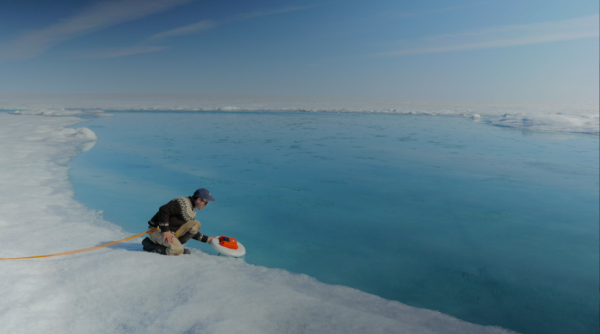Did Föhn Winds Just Melt Two Miles of East Antarctic Surface Ice in One Day?
28
November, 2016
It’s
right there in the satellite image. A swatch of blue that seems to
indicate an approximate 2-mile long melt lake formed over the surface
of East Antarctica in just one day. If confirmed, this event would be
both odd and concerning. A part of the rising signal that melt
stresses for the largest mass of land ice on the planet are rapidly
increasing.
(Possible
large melt lake on the surface of an ice shelf along the Scott Coast
appears in thisNASA
satellite image.
The melt lake seems to have formed after just one day during which
föhn winds ran downslope from the Transantarctic Mountain Range —
providing a potential period of rapid heating of the glacier
surface.)
Surface
Melt Now Showing Up in East Antarctica
While
scientists and environmentalists are understandably concerned about
ocean warming melting the undersides of sea-fronting West Antarctic
glaciers —
resulting in risks for rapid sea level rise for the near future,
another consequence of global warming is also starting have a more
visible impact on the frozen and now thawing continent. Surface melt,
which was hitherto unheard of for most of East Antarctica, is now
starting to pop up with increasing frequency.
East
Antarctica, according
to Stewart Jamieson, a glaciologist at Durham University in the
U.K.,
is “the part of the continent where people have for quite a long
time assumed that it’s relatively stable, there’s not a huge
amount of change, it’s very, very cold, and so, it’s only very
recently that the first supraglacial lakes, on top of the ice, were
identified.”
But
now, even in austral springtime, we find evidence of surface melt in
the satellite record.
On
November 27, 2016, what looks like an approximate 2 mile long melt
pond appeared in a section of ice shelf along the Scott
Coast and
just North of the Drygalski
Ice Tongue in
the region of McMurdo Sound. The lake — which is visible as a light
blue swatch at center mass in the NASA-MODIS satellite
image above — suddenly showed up in November 27 satellite image
along a region where only white ice was visible before. And it
appears in a region of East Antarctica that, before human-forced
warming altered the typically-stable Antarctic climate, had rarely,
if ever, seen surface melt.
(Near
melting point temperatures appear along the Scott Coast in
conjunction with an apparent föhn wind event. Image source: Earth
Nullschool.)
The
pond shows up coordinate with recorded near 0 C surface temperatures
in the GFS monitor for November 26-27 and along with evidence
of downsloping
(föhn) winds.
GFS indicators show downsloping winds gusting to in excess of 50 mph
over the period. Such
winds have the potential in increase surface temperatures by as much
as 14 degrees Celsius in a matter of minutes.
And they have, increasingly, produced surface glacial melt events in
regions of Greenland and Antarctica during recent years.
Surface
Melt as a Feature of Glacial Destabilization
Supraglacial
lake is just another word for a surface glacial melt lake. And these
new lakes pose a big issue for ice sheet stability. Surface melt
lakes are darker than white glacier surfaces. They act as lenses that
focus sunlight. And the comparatively warm waters of these lakes can
flood into the glacier itself — increasing the overall heat energy
of the ice mass.
(A
NASA researcher investigates a surface melt pond in Greenland. During
recent years, these climate change related features have become more
common in Antarctica. Image source: NASA.)
But
water at the glacier surface doesn’t just sit there. It often bores
down into the ice sheet — producing impacts for months and years
after the surface lake’s formation. Sub surface lakes can form in
the shadow of surface ponds. Transferring heat into the glacier year
after year. In other cases, water from these lakes punches all the
way to the glacier’s base. There the added lubrication of water
speeds the glacier’s flow. All of these processes generate stresses
and make glaciers less stable. And
it is the presence of surface melt ponds that has been responsible
for so much of Greenland’s speeding melt during recent years.
Now,
a similar process is impacting the largest concentration of land ice
on the planet. And while Greenland holds enough ice to raise sea
levels by around 21 feet, East Antarctica contains enough to lift the
world’s oceans by about 195 feet. Surface melt there, as a result,
produces considerably more risk to the coastal cities of the world.
Links:
Hat
tip to Shawn Redmond (and a special thanks for being the first here
to ID the rather odd apparent melt pond forming along the Scott
Coast.)






No comments:
Post a Comment
Note: only a member of this blog may post a comment.